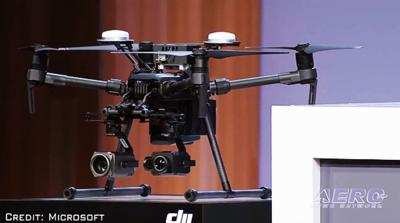Play it Again, HAL
Seattle tech titan, Microsoft, has launched a software platform that enables drone operators to train the artificial intelligence systems of their autonomous air-vehicles. Subject platform—dubbed AirSim—constitutes, in effect, a simulator for drones. AirSim facilitates training scenarios too risky to be attempted in actuality, such as operations near power-lines, nuclear reactors, or Gary, Indiana.

Microsoft claims the AirSim platform allows users to contemporaneously simulate multiple flight-environments and the variables thereof. For example, operators may virtually assess how far a particular Unmanned Air Vehicle (UAV) is capable of flying in rain, or how strong winds might affect its battery-life.
In a statement announcing the product’s launch, Microsoft corporate vice president Gurdeep Pall asserted AirSim demonstrated “the power of the industrial metaverse—the virtual worlds where businesses will build, test, and hone solutions, then bring them into the real world.”
Microsoft expects the AirSim technology will prove particularly relevant within the emergent autonomous air-taxi and drone delivery sectors.
Early access to the AirSim platform—which runs on Microsoft’s Azure cloud computing service—was granted to Airtonomy, a U.S. provider of robotics software and UAV services. Airtonomy’s drones inspect infrastructure the likes of wind-turbines and power-lines across the oil and gas, power-generation, power-distribution, telecommunications, and insurance industries.
Airtonomy CEO josh Riedy thusly described the conventional means by which wind-turbine blades are inspected: “A crew of three individuals rappelled down those blades; the towers are at a height of 80m (262 ft), so not only was it nearly a day-long job for three individuals, [sic] safety is certainly a consideration.”
Airtonomy drones fly autonomously and can be controlled by a single operator safely boots-down on the Earth. “"They simply need to know how to put batteries in a drone, and push a button," Mister Riedy remarked.
The inspection profiles flown by Airtonomy’s drones are developed in the virtual AirSim environment, which affords Airtonomy UAV programmers and operators opportunity to err without destroying expensive drones and blacking-out entire towns. The AirSim platform also permits developers to explore hypothetical scenarios too impractical or flat-out dangerous to undertake in the real world, e.g., bird-strikes, partial power-loss, degradation of UAV sensor acuity, loss of positioning data, etc.

In addition to libraries of digital environments, AirSim operators will have access to AI building-blocks, comprising data gleaned during past UAV training simulations.
Ashish Kapoor, creator of the original open-source AirSim software expressed hope that data gathered on the new platform would help put "many more vehicles in the sky, helping to monitor farms, inspect critical infrastructure, and transport goods and people to the remotest of places.” Such as Gary, Indiana.
 ANN's Daily Aero-Linx (05.02.24)
ANN's Daily Aero-Linx (05.02.24) ANN's Daily Aero-Term (05.02.24): Touchdown Zone Lighting
ANN's Daily Aero-Term (05.02.24): Touchdown Zone Lighting Aero-News: Quote of the Day (05.02.24)
Aero-News: Quote of the Day (05.02.24) ANN FAQ: Contributing To Aero-TV
ANN FAQ: Contributing To Aero-TV NTSB Final Report: Cirrus Design Corp SR20
NTSB Final Report: Cirrus Design Corp SR20




